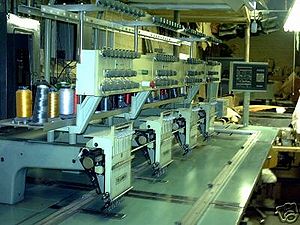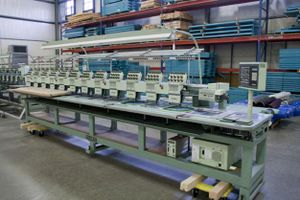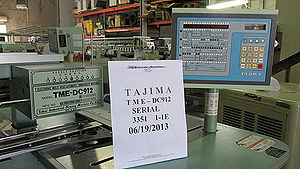Difference between revisions of "Tajima"
| Line 236: | Line 236: | ||
|} | |} | ||
</center> | </center> | ||
{{TajimaTEHX}} | |||
{{ | |||
}} | |||
==Tajima Legend== | ==Tajima Legend== | ||
Tajima used several codes in their models that described basic features of the machines. The letters in the model number usually | Tajima used several codes in their models that described basic features of the machines. The letters in the model number usually | ||
| Line 280: | Line 252: | ||
</gallery> | </gallery> | ||
</center> | </center> | ||
{{tajimaFooter}} | {{tajimaFooter}} | ||
Revision as of 19:41, 28 August 2013
{{#invoke:Infobox|infobox}}
Tajima is a manufacturer of single and multi-head embroidery machines. The Tajima embroidery machine company is based out of Japan. Tajima is one of the most well-known brands in embroidery machine manufacturing. Tokai Industrial Sewing Machines Co. LTD was the original manufactures of the machines distributed by Tajima.
Tajima Embroidery Machines (China) Co., Ltd. was established in 2001 in Jieyang, Guangdong, China, to manufacture machines in China.
Tajima has produced embroidery machines with 1, 2, 4, 6, 8, 10, 12, 15, 20 and 24 heads. In The United States most Tajima models are 1, 2, 4, 6 and 12 head. Most the 8 head machines and machines larger than 12 heads were more common in other countries. Very few 8 heads can be found in the United States but are much more common in Asian countries. Tajima has produced machines with 1, 3, 4, 6, 9, 12 and 15 needles. Machines with 6 needles are common in the very early 1990s. 9 needle machines became popular during the mid 1990s. Late 1990s to around 2010 most machines were 12 needles. 15 needle machines are standard now. Tajima machines with less than 6 needles are generally specialty machines.
History, origin and sales
The Tajima embroidery machine company rose to popularity in the United States between the very late 1980s and the very early 1990s. The early model Tajimas produced till around 1996 had a greenish color scheme. Around 1996, Tajima machines changed from the light green color scheme (with dark green logo) to their more common white color scheme with a green, pink and blue logo. Tajima, along with Barudan of Japan, became a top two embroidery machine maker in the USA. Both Barudan and Tajima continue to be the two leading makers of embroidery machines for the United States market.
Tajima continues to lead sales in most of the west and south of the USA whereas Barudan leads sales in the north and east. Most of the rest of the United States is evenly divided among the two major embroidery machines (Tajima and Barudan). Tajimas are more commonly seen around Mexico and most of Central America whereas Barudan tends to lead sales in countries such as Colombia, Peru, Venezuela. Countries such as Argentina, Canada, Brazil, and Chile are divided among both Tajima and Barudan for popularity rights.
Tajimas machines original ran off paper punch cards from the 1970s till the 1980s when they were replaced by paper tape. Paper tape was soon replaced by floppy drives. Most all Tajima machines today are now run off USB drives.
Other Equipment
In addition to Tajima producing single and multi-head embroidery machines, Tajima also produces chenille machines, and machines with sequin devices.
Software Extensions
Tajima DST (.dst) is the most common software extension for Tajima software and machines. However, Tajima uses several other embroidery software formats. Tajima DST is the most common embroidery format found.
Embroidery Machines
TMEF Series
{{#invoke:Infobox|infobox}}
Tajima also made a TMEF-HC version of the TMEF which was a large sewing area bridge version of the HC model (which is typically Arm style)
TMEF Specifications
| Model | Heads | Needles | EMB Space / Head | Max SPM | Pwr Cons. | Years | Color |
|---|---|---|---|---|---|---|---|
| TMEF-HC606 (G1) | 6 | 6 | emb Space | SPM | POWEW | 1990-1992 | Green |
| TMEF-HC612 (G1) | 12 | 6 | emb Space | SPM | POWEW | 1990-1992 | Green |
| TMEF-HC904 (G1) | 4 | 9 | emb Space | SPM | POWEW | 1990-1992 | Green |
| TMEF-HC906 (G1) | 6 | 9 | emb Space | SPM | POWEW | 1990-1992 | Green |
| TMEF-HC912 (G1) | 12 | 9 | emb Space | SPM | POWEW | 1990-1992 | Green |
| TMEF-HC906 (G2) | 6 | 9 | emb Space | SPM | POWEW | 1993-1994 | Green |
| TMEF-HC912 (G2) | 12 | 9 | emb Space | SPM | POWEW | 1993-1994 | Green |
TME-HC Series
{{#invoke:Infobox|infobox}}
In 1990 Tajima released the TME-HC series embroidery machine. The TME-HC did not come with a floppy disk drive and only came with ports for external readers such as an external paper tape reader or Floppy Drive. The machine came in options of 4,6, 12, 15 or 20 heads. The machine only had manually removable table tops (nothing automatic). The machine was only available as 6 or 9 needles.
1990-1992
In 1990 Tajima released their first TME-HC model. The original HC models had mechanical thread break detectors that ran off a mechanical cam system. When the machine made a color change, the lob of the cam would physically close the thread break detection circuit. The HC models from this era had pretension knobs apart from the heads located in front of the mechanical thread break detection system.
1993-1994
The TME-HC machines released after 1992 came with standard DU-10 power boxes for the X and Y card. Each head was equipped with individual thread break boards and sensors, replacing the original HC design. The machines from this era looked much more like their predecessor, the TME-DC. The last TME-HC machine was produced in 1994.
TME-HC Specifications
| Model | Heads | Needles | EMB Space / Head | Max SPM | Pwr Cons. | Years | Color |
|---|---|---|---|---|---|---|---|
| TME-HC606 (G1) | 6 | 6 | emb Space | SPM | POWEW | 1990-1992 | Green |
| TME-HC612 (G1) | 12 | 6 | emb Space | SPM | POWEW | 1990-1992 | Green |
| TME-HC904 (G1) | 4 | 9 | emb Space | SPM | POWEW | 1990-1992 | Green |
| TME-HC906 (G1) | 6 | 9 | emb Space | SPM | POWEW | 1990-1992 | Green |
| TME-HC912 (G1) | 12 | 9 | emb Space | SPM | POWEW | 1990-1992 | Green |
| TME-HC906 (G2) | 6 | 9 | emb Space | SPM | POWEW | 1993-1994 | Green |
| TME-HC912 (G2) | 12 | 9 | emb Space | SPM | POWEW | 1993-1994 | Green |
TME-DC Series
{{#invoke:Infobox|infobox}}
For the Tajima TME-DC user manual see Tajima TME-DC User Manual
In 1994 Tajima released the TME-DC series embroidery machine.
The Tajima TME-DC was the next model up from the TME-HC model produced the previous years before. Unlike the TME-HC machine, the Tajima TME-DC models came standard with a Floppy Disk Drive. The Tajima DC series also came with upgraded control panel, motors, and motor controllers. Many models of the Tajima DC also came with Hydraulic Tables but, standard removable table tops were still available on some for a lesser price. The Tajima TME-DC models were available in 6, 12, 15 and 20 heads. The early machines built in the early and mid 1990s were mostly 9 needles. Around year 2000 most all models were standard 12 needles.
The TME-DC machine was the first Tajima multihead machine with a floppy drive. The machine can also be upgraded to FloppyToUSB
1994-1996
The first models of the Tajima TME-DC series were green machines. The only green machines were produced 1994 - 1996. Some of the 1996 models might be white color. The machine either had removable tables or hydraulic tables.
The machine was very similar to the earlier TME-HC model but, had upgraded electronics including the control panel, IMM, IDM, motor, motor controller, etc. The machine also had a floppy drive which can be upgraded to Floppy To USB
1997-1999
The TME-DC machine changed color scheme and logos around 1996. The 1997 models of the TME-DC series were white but were otherwise very similar to the previous TME-DC machines. The white version was available later in 12 needles.
TME-DC Specifications
| Model | Heads | Needles | EMB Space / Head | Max SPM | Pwr Cons. | Years | Color |
|---|---|---|---|---|---|---|---|
| TME-DC906 (G1) | 6 | 9 | emb Space | SPM | POWEW | 1994-1996 | Green |
| TME-DC912 (G1) | 12 | 9 | emb Space | SPM | POWEW | 1994-1996 | Green |
TMFD Series
{{#invoke:Infobox|infobox}}
For the Tajima TMFD user manual see Tajima TMFD User Manual
The Tajima TMFD machine was a very popular machine known for its high output. The TMFD machines can be found in very large embroidery factories. The machine was very popular outside the USA where large embroidery factories are found.
1994-1996
The first TMFD machine was Green.
1997-20xx
Around the end of 1996 the Tajima machine color and logo where changed. The 1997 version of the TMFD featured the new color scheme and logo.
TMFD Specifications
| Model | Heads | Needles | EMB Space / Head | Max SPM | Pwr Cons. | Years | Color |
|---|---|---|---|---|---|---|---|
| TME-DC906 (G1) | 6 | 9 | emb Space | SPM | POWEW | 1994-1996 | Green |
| TME-DC912 (G1) | 12 | 9 | emb Space | SPM | POWEW | 1994-1996 | Green |
NEO
{{#invoke:Infobox|infobox}} The Tajima Neo is the only table-top, compact machine ever made by Tajima. The Neo is an entry-level machine in the Tajima lineup of embroidery machines. The first Tajima Neo was manufactured in 2002. In Tajima marketing materials, NEO stood for "Never Ending Opportunities" which was meant to emphasize the machine's ability to work with a wide variety of garments.
Around 2010 Tajima bought the Toyota Embroidery Machine rights.
The Tajima NEO borrowed a lot of the looks and electronics from Toyota. The Tajima NEO is sometimes refereed to as a clone of the Toyota 9000. Tajima has since discontinued the Toyota line. The machine that replaced the Toyota line is called Expert and is also very identical to the NEO as both are produced by the same company with very small changes.
(TEJTII-C) Series
The first Neo was the 2002 Tajima Neo II TEJT C1501. It was a single-head machine with a sewing field of 19.4 x 14inches, and was a scaled-down version of a standard commercial embroidery machine. The Neo II was portable and came with a stand (with wheels) which made it convenient for taking to sporting events, craft fairs, kiosks and trade shows. The Tajima Neo II series had 15-needle, 12-needle, and 9-needle versions. The Neo came with a floppy disk drive.
The 2004 Tajima Neo TEJT-C1501 featured 270 degree cap sash, tubular sash, one set of 270 cap frames, five sets of tubular hoops, removable table,
NEO Specifications
| Model | Heads | Needles | EMB Space / Head | Max SPM | Pwr Cons. | Years |
|---|---|---|---|---|---|---|
| TEJTII-C | 1 | 15 | 19.4 IN x 14 IN | SPM | POWEW | 2002 - Present |
Tajima Legend
Tajima used several codes in their models that described basic features of the machines. The letters in the model number usually
- TME
- Machines with TME in their code and nothing else besides
- TMEF
- Machines with the F code are Bridge Machine (not arm type). If there are not more letter codes then this machine is a flat only machine (does not to tubular or caps).
Head Gallery
Below are a few examples of the heads used for the Tajima machines over the years:
Tajima Legend
Tajima used several codes in their models that described basic features of the machines. The letters in the model number usually
- TME
- Machines with TME in their model without any other letters (numbers only) is a very late 1970s - 1990 flat only machine.
- TME-C
- Predecessor to the TME, a Tajima machine with a C in it represents Cylinder (tubular) embroidery. Therefore machines with the letter C in their model, have removable tables.
- TME-HC, TMEF-H, H
- Models with H in their model have the H model control panels. A TME-HC is an Arm Type machine with removable tables and the H model control panel. A TMEF-H machine is a flat machine with the H model control panel.
- TMEF
- Machines with the F code are Bridge Machine (not arm type). If there are not more letter codes then this machine is a flat only machine (does not to tubular or caps).
- TMM
- TMM machines were collaboration Melco and Tajima machines. These machines have a Melco control panel/keyboard.
Tajima Years, Date or Age
The year of the Tajima machine can usually be found on a sticker behind the machines control panel or power boxes. These years are usually the year that the machines electronics were Quality Control checked at the Japan factory. The months listed on these stickers will probably be different. It usually took about 3 months from production to delivery to the original customers location. Later models had the production year stamped on the data plate.
If the machine is old and does not have a sticker, then the machine is probably older than 1990.
Buying
Tajima embroidery machines are probably one of the best machines on the market. They are more expensive that most all competing models but, they are very solidly built and have a good resell market. There are a lot of embroidery machine technicians available world wide and parts are pretty easy to find even for older models.
Selling
TheEmbroideryWarehouse buys and sells most every make and model of Tajima embroidery machines located within the continental USA. They also purchase parts, parts machines, salvage machines and most everything else related to embroidery equipment.



